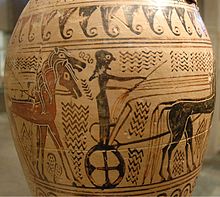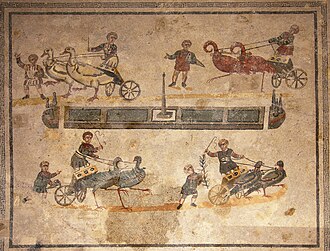
The Circus Maximus is an ancient Roman chariot-racing stadium and mass entertainment venue in Rome, Italy. In the valley between the Aventine and Palatine hills, it was the first and largest stadium in ancient Rome and its later Empire. It measured 621 m (2,037 ft) in length and 118 m (387 ft) in width and could accommodate over 150,000 spectators. In its fully developed form, it became the model for circuses throughout the Roman Empire. The site is now a public park.
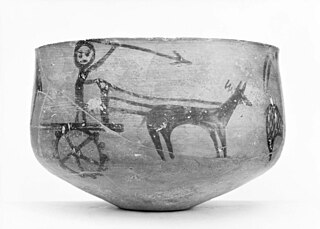
A chariot is a type of cart driven by a charioteer, usually using horses to provide rapid motive power. The oldest known chariots have been found in burials of the Sintashta culture in modern-day Chelyabinsk Oblast, Russia, dated to c. 1950–1880 BCE and are depicted on cylinder seals from Central Anatolia in Kültepe dated to c. 1900 BCE. The critical invention that allowed the construction of light, horse-drawn chariots was the spoked wheel.

In Sabine and ancient Roman religion and myth, Luna is the divine embodiment of the Moon. She is often presented as the female complement of the Sun, Sol, conceived of as a god. Luna is also sometimes represented as an aspect of the Roman triple goddess, along with Diana and either Proserpina or Hecate. Luna is not always a distinct goddess, but sometimes rather an epithet that specializes a goddess, since both Diana and Juno are identified as moon goddesses.

Chariot racing was one of the most popular ancient Greek, Roman, and Byzantine sports. In Greece, chariot racing played an essential role in aristocratic funeral games from a very early time. With the institution of formal races and permanent racetracks, chariot racing was adopted by many Greek states and their religious festivals. Horses and chariots were very costly. Their ownership was a preserve of the wealthiest aristocrats, whose reputations and status benefitted from offering such extravagant, exciting displays. Their successes could be further broadcast and celebrated through commissioned odes and other poetry.

The Hippodrome of Constantinople, was a circus that was the sporting and social centre of Constantinople, capital of the Byzantine Empire. Today it is a square in Istanbul, Turkey, known as Sultanahmet Square.

A quadriga is a car or chariot drawn by four horses abreast and favoured for chariot racing in Classical Antiquity and the Roman Empire. The word derives from the Latin quadrigae, a contraction of quadriiugae, from quadri-: four, and iugum: yoke. In Latin the word quadrigae is almost always used in the plural and usually refers to the team of four horses rather than the chariot they pull. In Greek, a four-horse chariot was known as τέθριππον téthrippon.
The Robigalia was a festival in ancient Roman religion held April 25, named for the god Robigus. Its main ritual was a dog sacrifice to protect grain fields from disease. Games (ludi) in the form of "major and minor" races were held. The Robigalia was one of several agricultural festivals in April to celebrate and vitalize the growing season, but the darker sacrificial elements of these occasions are also fraught with anxiety about crop failure and the dependence on divine favor to avert it.

Cynisca or Kyniska was a wealthy Spartan princess. She is famous for being the first woman to win at the Olympic Games, competing in the sport of chariot racing. Cynisca first entered the Olympics in 396 BC, where she won first prize competing with a team of horses she had trained herself. In 392 BC, Cynisca entered her horses in the Olympics for a second time and was awarded another victory in the same event.

Progress of the State is the title of a group of sculptural figures that sits above the south portico, at the main entrance to the Minnesota State Capitol in Saint Paul, the state capital of the U.S. state of Minnesota.
The Ludi Romani was a religious festival in ancient Rome. Usually including multiple ceremonies called ludi. They were held annually starting in 366 BC from September 12 to September 14, later extended to September 5 to September 19. In the last 1st century BC, an extra day was added in honor of the deified Julius Caesar on 4 September. The festival first introduced drama to Rome based on Greek drama.

Gaius Appuleius Diocles was a Roman charioteer. His existence and career are attested by two highly detailed contemporary inscriptions, used by modern historians to help reconstruct the likely conduct and techniques of chariot racing. He has been described in some modern sources as the highest-paid athlete of all time.
In Greek mythology, the Taraxippus was a presence, variously identified as a ghost or dangerous site, blamed for frightening horses at hippodromes throughout Greece. Some taraxippoi were associated with the Greek hero cults or with Poseidon in his aspect as a god of horses who brought about the death of Hippolytus. Pausanias, the ancient source offering the greatest number of explanations, regards it as an epithet rather than a single entity.
Porphyrius the Charioteer, also named Porphyrius Calliopas was a celebrity Byzantine-Roman charioteer in the late 5th and early 6th century, during what Alan Cameron has described as the "golden age" of Byzantium's hippodrome, and of the Byzantine charioteer.

The trigarium was an equestrian training ground in the northwest corner of the Campus Martius in ancient Rome. Its name was taken from the triga, a three-horse chariot.
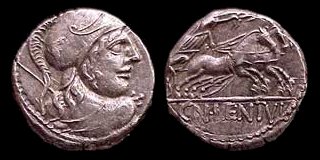
In the currency of ancient Rome, the bigatus is a type of denarius stamped on the reverse with a biga, a two-horse chariot. It began to appear in the first decade of the 2nd century BC as an alternative to the victoriatus, and most numismatists believe that it was not used before 190 BC. A denarius with a four-horse chariot (quadriga) had already been in use for some time; see quadrigatus, likewise named for its chariot icon and depicting in addition the Dioscuri.

In ancient Rome, the pompa circensis was the procession that preceded the official games (ludi) held in the circus as part of religious festivals and other occasions.

The di inferi or dii inferi were a shadowy collective of ancient Roman deities associated with death and the underworld. The epithet inferi is also given to the mysterious Manes, a collective of ancestral spirits. The most likely origin of the word Manes is from manus or manis, meaning "good" or "kindly," which was a euphemistic way to speak of the inferi so as to avert their potential to harm or cause fear.

In ancient Roman religion, the October Horse was an animal sacrifice to Mars carried out on October 15, coinciding with the end of the agricultural and military campaigning season. The rite took place during one of three horse-racing festivals held in honor of Mars, the others being the two Equirria on February 27 and March 14.
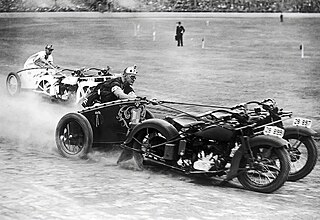
Motorcycle chariot racing is a motor sport that combines motorcycle racing and chariot racing.

The spectacles in ancient Rome were numerous, open to all citizens and generally free of charge; some of them were distinguished by the grandeur of the stagings and cruelty.

